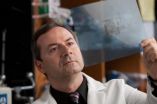Study links hypoxia and inflammation in many diseases
University of Colorado researchers focus on how the body adapts
2011-02-20
(Press-News.org) Yet some athletes deliberately train at high altitude, with less oxygen, so they can perform better. Their bodies adapt to the reduced oxygen.
Now a doctor at the University of Colorado School of Medicine has explored the relationship between lack of oxygen, called hypoxia, and the inflammation that can injure or kill some patients who undergo surgery. In a liver transplant, for example, the surgery and anesthesiology can go perfectly yet the new liver will fail because of hypoxia.
"Understanding how hypoxia is linked to inflammation may help save lives of people who have survived a major surgery only to be faced with potential harm to major organs," says Holger K. Eltzschig, MD, PhD.
Eltzschig's exploration of the relationship between hypoxia and inflammation was published Feb. 17 in the New England Journal of Medicine. His work was supported by more than $1 million from the National Institutes of Health.
Those high-altitude athletes figured into the research. How do their bodies adapt to low levels of oxygen? And how can that information help patients?
The answer appears to lie at the molecular level. The body can signal a helpful response to deal with low oxygen levels. To do so it uses what's called hypoxia-inducible factor (HIF). This is a protein that sends complex signals to help the body defend itself.
Eltzschig says that research now should focus on understanding more about the way these signals function.
"By focusing on the molecular pathways the body uses to battle hypoxia, we may be able help patients who undergo organ transplants, who suffer from infections or who have cancer," says Eltzschig, a professor of anesthesiology, medicine, cell biology and immunology.
"We know the body can do this. Our research goal now is to find out exactly how."
###
Faculty at the University of Colorado School of Medicine work to advance science and improve care. These faculty members include physicians, educators and scientists at University of Colorado Hospital, The Children's Hospital, Denver Health, National Jewish Health, the Denver Veterans Affairs Medical Center. The school is located on the Anschutz Medical Campus, one of four campuses in the University of Colorado system. To learn more about the medical school's care, education, research and community engagement, please visit its web site. For additional news and information, please visit the UC Denver newsroom online.
END
ELSE PRESS RELEASES FROM THIS DATE:
2011-02-20
A powerful solar flare has ushered in the largest space weather storm in atleast four years and has already disrupted some ground communications on Earth, said University of Colorado Boulder Professor Daniel Baker, an internationally known space weather expert.
Classified as a Class X flare, the Feb. 15 event also spewed billions of tons of charged particles toward Earth in what are called coronal mass ejections and ignited a geomagnetic storm in Earth's magnetic field, said Baker, director of CU-Boulder's Laboratory for Atmospheric and Space Physics. Such powerful ejections ...
2011-02-20
When studying relationships, psychological scientists have often focused on how couples fight. But how they recover from a fight is important, too. According to a new study published in Psychological Science, a journal of the Association for Psychological Science, couples' abilities to bounce back from conflict may depend on what both partners were like as infants.
Researchers at the University of Minnesota have been following a cohort of people since before they were born, in the mid-1970s. When the subjects were about 20 years old, they visited the lab with their romantic ...
2011-02-20
LOS ANGELES (February 18, 2011) – Scientists at the Children's Center for Cancer and Blood Diseases and The Saban Research Institute of Children's Hospital Los Angeles today announced a breakthrough discovery in understanding how the body fights leukemia. They have identified a protein called CD19-ligand (CD19-L) located on the surface of certain white blood cells that facilitates the recognition and destruction of leukemia cells by the immune system. This work represents the first report of a bioengineered version of CD19-L, a recombinant human biotherapeutic agent, ...
2011-02-20
PITTSBURGH, Feb. 18 – Only one out of more than 1,900 people evaluated met the American Heart Association (AHA) definition of ideal cardiovascular health, according to a new study led by researchers at the University of Pittsburgh School of Medicine. Their findings were recently published online in Circulation.
Ideal cardiovascular health is the combination of these seven factors: nonsmoking, a body mass index less than 25, goal-level physical activity and healthy diet, untreated cholesterol below 200, blood pressure below 120/80 and fasting blood sugar below 100, explained ...
2011-02-20
DALLAS – Feb. 17, 2011 – Low levels of the anti-aging hormone Klotho may serve as an early warning sign of the presence of kidney disease and its deadly cardiovascular complications, according to findings by UT Southwestern Medical Center researchers.
Using mice, investigators found that soft-tissue calcification, a common and serious side effect of chronic kidney disease (CKD), improves when Klotho hormone levels are restored. The study is available online in the Journal of the American Society of Nephrology.
The essential Klotho protein, which is produced by the kidneys, ...
2011-02-20
One bad apple is all it takes to spoil the barrel. And one misfolded protein may be all that's necessary to corrupt other proteins, forming large aggregations linked to several incurable neurodegenerative diseases such as Huntington's, Parkinson's and Alzheimer's.
Stanford biology Professor Ron Kopito has shown that the mutant, misfolded protein responsible for Huntington's disease can move from cell to cell, recruiting normal proteins and forming aggregations in each cell it visits.
Knowing that this protein spends part of its time outside cells "opens up the possibility ...
2011-02-20
Researchers from the Georgia Institute of Technology have created a new sampling device that could prevent thousands of people worldwide from dying of pneumonia each year.
Called PneumoniaCheck, the device created at Georgia Tech is a solution to the problem of diagnosing pneumonia, which is a major initiative of the U.S. Centers for Disease Control and Prevention (CDC).
Pneumonia, an inflammation of the lungs, kills about 2.4 million people each year. The problem is particularly devastating in Africa, Southeast Asia and the Eastern Mediterranean, where a child dies ...
2011-02-20
The most widely prescribed antidepressants – medicines such as Prozac, Lexapro and Paxil – work by blocking the serotonin transporter, a brain protein that normally clears away the mood-regulating chemical serotonin. Or so the current thinking goes.
That theory about how selective serotonin reuptake inhibitors (SSRIs) work can now be put to the test with a new mouse model developed by neuroscientists at Vanderbilt University.
These mice, described in the online edition of the Proceedings of the National Academy of Sciences (PNAS), express a serotonin transporter that ...
2011-02-20
While a world free of nuclear weapons remains a goal for governments around the world, nuclear security constitutes a major challenge for the 21st century, as recognised at the 2010 nuclear security summit in Washington. Citizens are generally aware of international efforts to prevent the proliferation of nuclear weapons, but they are often unaware of nuclear security research and the important role science in this field. A new European nuclear security training centre and enhanced international collaboration are good examples.
A recent survey on the EU´s radiological ...
2011-02-20
To build the next generation of sensors – with applications ranging from medical devices to robotics to new consumer goods – Chang Liu looks to biology.
Liu, professor of mechanical engineering and electrical engineering and computer science at Northwestern University's McCormick School of Engineering and Applied Science, is using insights from nature as inspiration for both touch and flow sensors — areas that currently lack good sensors for recording and communicating the senses.
Liu will discuss his research in a symposium at the annual meeting of the American Association ...
LAST 30 PRESS RELEASES:
[Press-News.org] Study links hypoxia and inflammation in many diseases
University of Colorado researchers focus on how the body adapts


